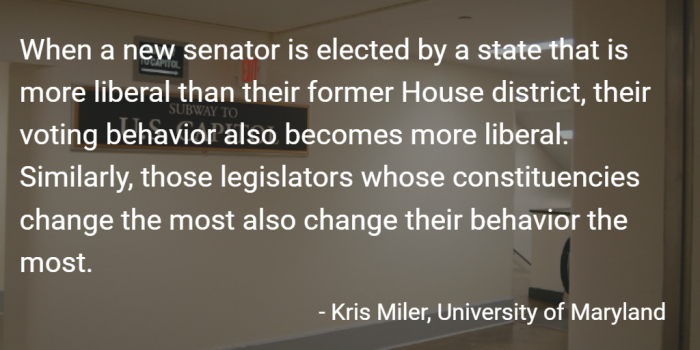 Few politicians represent one constituency for the entirety of their political life. Many graduate from the House of Representatives to the Senate, a move which also usually involves a massive increase in the number of constituents that they represent. Do these shifts then affect how legislators act and the kinds of laws they support. In new research which examines the legislative behavior of House members who move up into the Senate, Kristina Miler finds when a new senator is elected by a state that is more liberal than their former House district their voting behavior does become more liberal.
Few politicians represent one constituency for the entirety of their political life. Many graduate from the House of Representatives to the Senate, a move which also usually involves a massive increase in the number of constituents that they represent. Do these shifts then affect how legislators act and the kinds of laws they support. In new research which examines the legislative behavior of House members who move up into the Senate, Kristina Miler finds when a new senator is elected by a state that is more liberal than their former House district their voting behavior does become more liberal.
We apply many labels to elected politicians: Democrat, Republican, liberal, free-trader, and union supporter, among others. These political identities imply a certain consistency in the behavior of elected politicians over time. Yet I find that legislators behave quite differently in cases where they begin to represent a different constituency than the one they represented previously. This evidence, drawn from the behavior of more than 100 members of the US Congress that moved from the House to the Senate, demonstrates legislators’ strong desire to represent constituents, even if it requires them to shift away from previous ideological positions.
Legislators in many democracies are tasked with representing a constituency that is defined geographically. But a politician’s constituency can change, sometimes dramatically, over the course of their political life. Sometimes members move from one legislative venue to another, such as those who move from a sub-national parliament (Welsh or Scottish) or legislature (US states) to a national one (House of Commons, US Congress). Similarly, politicians may serve in the European parliament and then move to a national parliament where they represent a new constituency.
Constituencies can even change when one stays in the same legislative body. Between 1993 and 2014, 30 countries, including Mexico, South Africa, and Italy changed their electoral systems. In countries with mixed electoral systems, a member may shift from being a list MP to a constituency one, or vice-versa. More generally, boundary commissions across democracies regularly redraw political boundaries, creating changed constituencies. In the United States, the visible and often highly political process of congressional redistricting can leave sitting House members with a new district.
To understand whether and how constituency change affects legislative behavior, I examined the members of Congress since 1960 that have “moved up” from the 435-person House of Representatives to the 100-member Senate. For these chamber-changers, moving to the Senate provides them with a new, state-wide constituency to whom they are accountable instead of a smaller House district.
This change can be minor or major, and for both Democrats and Republicans, the new statewide constituency can be more or less liberal (or conservative) than the one they previously represented. For instance, Democrat Sherrod Brown moved from the 13th District of Ohio, a working class district made up of counties west of Cleveland, to representing the entire state of Ohio, which is more diverse economically, less diverse racially, and more conservative politically.
There are competing logics for whether such constituency change should affect how a legislator behaves. On the one hand, the preeminent view is that the legislator’s behavior should not change. Since the legislator holds the same ideology and remains in the same political party, those factors should continue to determine their behavior as it did before.
But on the other hand, these chamber-changers become electorally accountable to a different set of constituents. According to the logic of congressional scholars who have long emphasized the importance of the electoral connection in American politics, members should adapt their behavior to better reflect their new constituency.
Gauging whether (and how) legislators behave differently after changing chambers requires finding a common metric for observing and tracing their legislative behavior over time. As a primary measure, I utilize a highly-comparable, adjusted version of the voting scores produced by the Americans for Democratic Action (ADA). These well-known scores are widely used to measure legislators’ behavior along a liberal-conservative spectrum and function much like an inflation index for consumer prices that allows one to compare prices over time and space. I compare changes in the scores across varying time windows before and after each legislator’s move from the House to the Senate together with the accompanying constituency change.
Careful analysis of these data reveal sizeable changes in the behavior of those whose constituencies have changed. Initial statistical tests confirm that the behavior of legislators who move from the House to the Senate is meaningfully different before and after the change. The evidence of changed behavior is consistently strong, regardless of whether the comparison is made across two, four, or six-year windows before and after they change chambers, or across their entire careers.

These findings are robust to measurement choices and the consideration of alternate explanations. I find the same significant changes when I substitute the also-popular DW-NOMINATE scores as a measure of legislator behavior. Furthermore, both Democrats and Republicans are highly responsive to constituency change and this holds regardless of changes in majority party status, the party of the president, or unique features of each Congress.
As expected, the direction and magnitude of the change in legislative behavior tracks the direction and scale of the change in the constituency. When a new senator is elected by a state that is more liberal than their former House district (as measured by the respective constituencies’ vote in the most recently held presidential election), their voting behavior also becomes more liberal (and the same is true for conservative shifts). Similarly, those legislators whose constituencies change the most also change their behavior the most.
These changes can be large and substantively meaningful. The vote scores of chamber-changers shift across a 48-point range, going from 28 points more liberal to 20 points less liberal (more conservative). Subsequently, some members’ vote scores change by 20 points or more when they move from representing a House district to the entire state in the Senate. The larger shifts in constituency preferences translate into a change from a yes to a no vote (or vice-versa) on three or more major votes per year.
Real-world examples, both past and present, illustrate these dynamics. Ron Wyden (D-OR) moved to a Senate constituency that was 10 percentage points less supportive of the Democratic presidential candidate than his House district had been. His response to this change in his constituency was a voting record in the Senate that was more than 9 point lower (less liberal) than his record in the House. By contrast, Charles Mathias (R-MD) represented a statewide constituency that was 10 percentage points more supportive of the Democratic presidential candidate than his House constituency, and his response to this change in constituency was an adjusted ADA score 17 points higher (more liberal) than his record in the House.
This evidence of responsiveness to constituency change may seem intuitive, but if one thinks about how we talk about politics, it is not so clear. When legislators get a new constituency, they are still the same person, with the same partisanship and professed ideology – the two features that seem to drive American politics. Indeed, the evidence presented here contrasts sharply with prior research on the topic as well as conventional wisdom.
Lastly, these findings should be viewed positively. A central tenet of representative democracy is that elected representatives should reflect the preferences and interests of the individuals on whose behalf they speak. The evidence presented here suggests that legislators (and potentially voters) are less concerned about Members of Congress appearing to change past positions than about being unresponsive to their new constituents. I find that those representatives faced with a new constituency are indeed responsive to the new collection of voters, in both the appropriate direction and to the appropriate degree, which is welcome news for the health of representative democracy.
This article is based on the paper, ‘Legislative Responsiveness to Constituency Change’, in American Politics Research.
Featured image credit: Greg Palmer (Flickr, CC-BY-2.0)
Please read our comments policy before commenting.
Note: This article gives the views of the author, and not the position of USAPP – American Politics and Policy, nor of the London School of Economics.
Shortened URL for this post: http://bit.ly/2cQkWHn
_________________________________________
 Kris Miler – University of Maryland
Kris Miler – University of Maryland
Kris Miler is an Assistant Professor in the Department of Government and Politics at the University of Maryland. Her research interests focus on political representation, especially in the US Congress. She is the author of Constituency Representation in Congress: The View from Capitol Hill (Cambridge University Press, 2010), which won the Alan Rosenthal Award from the American Political Science Association for the best book or article of potential value to legislative practitioners. Her research has appeared in the Journal of Politics, Legislative Studies Quarterly, Political Psychology, and American Politics Research. She is currently writing a book on the political representation of the poor in the US Congress.












